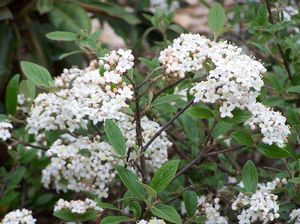View All Plants :: View All BROADLEAF EVERGREEN SHRUBS :: View All DECIDUOUS SHRUBS
Viburnum x burkwoodii 'Conoy'
Burkwood Hybrid Viburnum
Plant Type:
BROADLEAF EVERGREEN SHRUBSViburnum x burkwoodii ‘Conoy’ – This hybrid with V. utile (Service Viburnum) in its parentage is low-growing and mounding, wider in spread than in height. The rich green lacquer-finished obovate leaves have a pale bluish underside. They turn deep dark glossy maroon in the fall. As the autumn progresses in USDA zone 5b the outermost leaves acquire a lacquered bronze to black finish while the interior leaves remain a dark lime green. Creamy white flowers are 2” to 2.5” diameter followed by glossy egg-shaped red drupes that mature black. Regarding USDA hardiness: Though many sources indicate zone 5 hardiness in our experience we think that better success will be had in the warmer part of zone 5 (5b). 'Conoy' may settle in happily in 5a but we believe a sheltered spot in plenty of winter sun will increase chances of viability. This is a plant of great merit that will remain evergreen in warmer climes. ‘Conoy’ is small enough for a foundation garden or used as a front-of-the-border shrub facing down taller plants. A National Arboretum intro.
Characteristics and Attributes for Viburnum x burkwoodii 'Conoy'
Season of Interest (Flowering)
- Spring
Season of Interest (Foliage)
- Four Seasons
Autumn Interest
- Autumn Leaf Color
- Fruit / Berries / Seed Heads
Nature Attraction
- Deer Resistant
- Songbirds
- Honey Bees & Native Bees
Light
- Full Sun
Attributes
- Labyrinth
- Border
- Shrub Border
- Evergreen
- Hedgerow
- Foundation
- Wildlife Garden
- Rock Garden
Growth Rate in the Garden
- Slow
Soil
- Fertile
Origins
- Garden Origin
Propagated By
- Cutting Grown
Genus Overview: Viburnum
Common Name: Viburnum
Viburnum. This genus is full of fantastic, multi-season garden worthy shrubs. Garden heroes. Spring flowers, often large and showy, many with heady sweet fragrance are arranged in cymes. Some smell of musk (Viburnum dilatatum) while others produce no fragrance at all. Flowers are followed with berries. If late season and autumn berries are desired then planting two of a species will ensure fruit set; for instance, Viburnum dilatatum 'Erie' and V. dilatatum 'Michael Dodge' will pollinate each other and produce fruit. Viburnum cassinoides is closely allied with V. nudum; but if the flowering times do not overlap then there will be no fruit. However, if you plant V. nudum 'Winterthur' in proximity with V. nudum var. angustifolium, 'Longwood', 'Moonshine' or 'Pink Beauty' berries will abound. Another interesting example is V. lantana which crosses with V. burejaeticum and vice versa. Any V. plicatum f. tomentosum selection such as 'Shasta' or 'Shoshoni' will pollinate with all other V. plicatum f. tomentosum selections like 'Copper Ridges or 'Pink Beauty'. But if you were to plant two 'Shasta' side by side with no other V. plicatum f. tomentosum in near proximity then your effort will be fruitless. As with almost all in the universe of plants there are exceptions. There is one viburnum which appears to be self-fruitful, Viburnum setigerum the Tea Viburnum. Another interesting exception to the rule is Viburnum nudum 'Pink Beauty' which is also self-fruitful - a departure from its siblings. And on the other spectrum are two I can think of off-hand that are barren, Viburnum plicatum 'Roseum' and Viburnum plicatum 'Kern's Pink'. Oftentimes, the dwarf viburnums reamin in a juvenile state and do not produce fruit. All Viburnum of any size that do produce fruit are magnificent in the late season garden. And they feed all manner of birds. Larger, denser shrubs provide cover and nesting opportunities. Nearly all Viburnum have terrific autumn foliage colors, too. Viburnums are members of Caprifoliaceae. All prefer part to full sun and fertile soils. All are cutting grown. Many thanks to Gary Ladman of Classic Viburnums who generously set us straight regarding some of the details we had originally incorrectly lauded... ya can't know everything!


